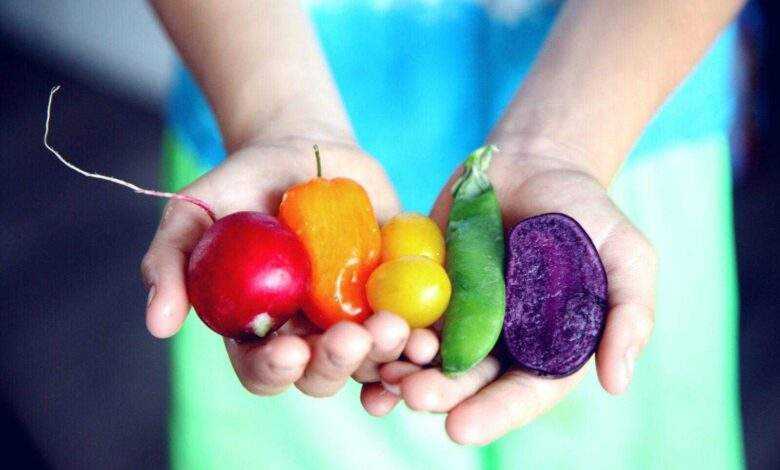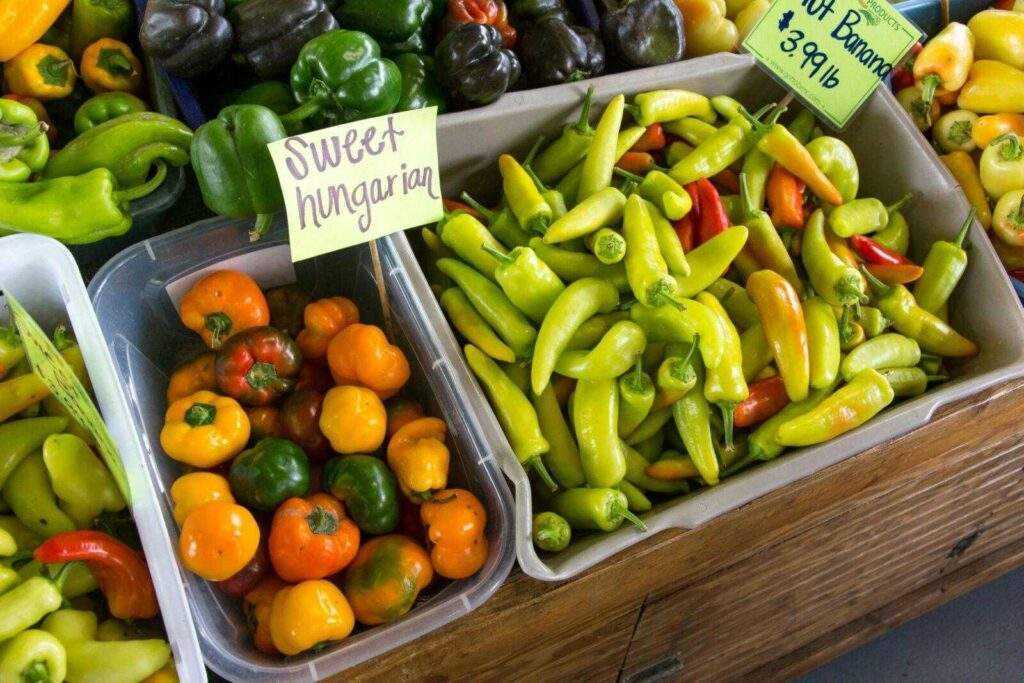Local Food, Local Wellness: The Benefits of Eating Seasonally and Supporting Local Farmers

Table of Contents
Imagine Sarah, a busy mother juggling work deadlines and school pickups, feeling the weight of hectic schedules and the challenge of providing nutritious meals amidst convenience-driven food choices. One crisp Saturday morning, seeking respite from the monotony of supermarket aisles, she stumbles upon her local farmers market. Drawn in by the vibrant colors of freshly harvested vegetables and the earthy aroma of just-baked bread, Sarah decides to explore further. As she chats with the farmers, tasting samples of sun-ripened strawberries and crisp apples, Sarah feels a connection she never experienced amidst the sterile, fluorescent-lit aisles of the grocery store. This newfound discovery sparks her journey into the world of local food and seasonal eating, transforming not just her diet but her entire perspective on food and wellness.
Problem
In today’s fast-paced world, many of us are increasingly disconnected from the origins of our food. The convenience of processed and pre-packaged foods has become the norm, leading to concerns about nutritional quality, food miles, and environmental impact. This disconnect not only affects our health but also our understanding of where our food comes from and how it’s produced. As more food travels long distances to reach our plates, the environmental footprint grows, contributing to carbon emissions and packaging waste. Moreover, industrial agriculture practices can lead to soil degradation, water pollution, and loss of biodiversity, further exacerbating environmental challenges.
Solution
Enter local food systems and seasonal eating as a refreshing antidote to these challenges. By embracing locally grown produce and seasonal ingredients, individuals like Sarah can enjoy fresher, more nutrient-dense foods while reducing their carbon footprint. Local food systems emphasize direct relationships between consumers and farmers, fostering transparency and trust in food production practices. Seasonal eating aligns with the natural rhythms of agriculture, supporting sustainable farming methods that conserve resources and promote biodiversity. It’s about re-establishing a connection to our food sources and supporting practices that prioritize health, sustainability, and community resilience.
Benefits
Discovering the benefits of local and seasonal eating opens a world of advantages:
- Increased Nutrient Content: Fresher produce retains more vitamins and minerals essential for optimal health. Locally grown fruits and vegetables are often picked at peak ripeness and delivered to markets shortly thereafter, preserving their nutritional integrity.
- Enhanced Flavor and Freshness: Seasonal foods are harvested at peak ripeness, offering superior taste and texture compared to imported alternatives that may have been harvested prematurely for transport.
- Supporting Local Farmers and Economies: By purchasing directly from farmers at markets or through Community Supported Agriculture (CSA) programs, consumers invest in local economies and help sustain small-scale farming. This support contributes to job creation and economic vitality within communities.
- Environmental Sustainability: Reducing the carbon footprint associated with food transportation and storage significantly lowers greenhouse gas emissions. Local food systems prioritize energy-efficient practices and minimize packaging waste, promoting environmental conservation.
- Reduced Food Waste: Seasonal eating reduces surplus production and spoilage, aligning with nature’s natural abundance cycles. This approach helps minimize food waste and supports efficient resource use throughout the food supply chain.
- Connection to the Land and Food System: Understanding the origins of our food fosters appreciation for the labor and resources involved in sustainable food production. It encourages a deeper connection to local ecosystems and traditional agricultural practices, promoting cultural heritage and environmental stewardship.
- Potential Cost Savings on Groceries: Seasonal foods often cost less due to reduced transportation and storage costs, making healthy eating more accessible and affordable for families and individuals alike.

Understanding Local Food Systems and Seasonal Eating
What is Local Food?
Local food refers to food that is produced and consumed relatively close to where it is grown or raised. It emphasizes direct relationships between consumers and producers within a defined geographic region. The concept of local food is often associated with the idea of “food miles,” which measures the distance food travels from farm to table. The shorter the distance, the fewer resources used for transportation, resulting in lower carbon emissions and environmental impact.
Benefits of Local Food:
- Fresher Produce with Higher Nutritional Value: Local foods are often harvested at peak ripeness and delivered promptly, retaining their maximum nutritional content and flavor.
- Supporting Local Farmers and Businesses: By purchasing local produce, consumers directly support small-scale farmers and local economies, contributing to community vitality and economic resilience.
- Environmental Sustainability and Reduced Carbon Footprint: Shorter transportation distances reduce fuel consumption and greenhouse gas emissions associated with food transportation. Local food systems also prioritize sustainable farming practices that conserve natural resources and promote biodiversity.
- Greater Control Over Food Production Practices: Consumers can inquire about farming methods and make informed choices that align with their values regarding organic, regenerative, or pesticide-free farming practices.
- Increased Variety and Seasonality in Diets: Local food systems offer a diverse range of seasonal fruits, vegetables, and artisanal products that vary throughout the year, encouraging a varied and nutritious diet.
- Potential for Lower Costs with Reduced Transportation: While prices may reflect the true cost of sustainable farming practices, eliminating long-distance shipping costs can sometimes lead to competitive pricing compared to imported goods.
What is Seasonal Eating?
Seasonal eating involves consuming foods that are harvested at the same time of year they are consumed. It aligns with the natural growing cycles of plants and supports local agriculture by promoting the consumption of produce when it is most abundant and flavorful.
Benefits of Seasonal Eating:
- Fresher, More Flavorful Produce at its Peak: Seasonal foods are harvested when they are fully ripe, resulting in superior taste, texture, and nutritional content compared to out-of-season produce that is often picked early and ripened artificially.
- Increased Variety and Nutrient Content in Diets: Eating seasonally introduces a wider array of fruits, vegetables, and herbs into one’s diet, providing a broad spectrum of essential vitamins, minerals, and antioxidants.
- Supporting Sustainable Farming Practices: Seasonal eating supports sustainable agriculture by reducing the need for artificial inputs like pesticides and fertilizers and promoting crop rotation and soil health.
- Potential Cost Savings by Consuming Seasonal Produce: Seasonal foods are typically more abundant and less expensive due to reduced transportation and storage costs, making healthy eating more accessible.
- Learning About Different Fruits and Vegetables: Seasonal eating encourages exploration and experimentation with new foods, fostering culinary creativity and expanding one’s palate.
- Encourages Creativity in Meal Planning: Planning meals around seasonal availability inspires innovative cooking techniques and recipes that highlight the flavors and textures of fresh, local ingredients.
Challenges and Solutions
Despite the benefits, there are challenges associated with finding local food and eating seasonally:
- Limited Access: Not all regions have easy access to local produce or farmers markets. Urban areas may have more options, while rural communities may struggle with availability.
- Higher Upfront Costs: Initial costs of joining Community Supported Agriculture (CSA) programs or purchasing organic local produce can be higher than conventional options.
Finding Farmers Markets and CSAs (Community Supported Agriculture)
- Farmers Markets: These markets connect consumers directly with local farmers and producers, offering a variety of fresh produce, meats, dairy, and artisanal goods. Websites like LocalHarvest.org provide directories to find farmers markets near you.
- CSA Programs: CSA allows consumers to buy a share of a farm’s harvest in advance, typically receiving weekly boxes of seasonal produce. This model supports farmers financially and offers consumers a steady supply of fresh, locally grown food.
Joining a Local Food Co-op
- Cooperatives: These member-owned organizations pool resources to purchase food directly from local farmers and producers at competitive prices. Co-ops often prioritize organic and sustainable practices.
Exploring Community Gardens and Urban Farming Initiatives
- Community Gardens: These collaborative spaces allow individuals or families to grow their own food and build community connections. Local government websites or community centers often list available gardens and plots.
Planning Meals Around Seasonal Availability
- Meal Planning Apps and Resources: Apps like Seasonal Food Guide provide information on what produce is in season in your region, helping you plan meals that align with local availability and reduce food waste.

A Guide to Seasonal Produce in the United States
Eating seasonally not only ensures fresher and more nutritious foods but also supports local farmers and reduces environmental impact. Here’s a comprehensive seasonal produce guide for different regions in the US, along with recipe inspiration to maximize each season’s bounty.
Seasonal Produce Calendar
Spring (March to May)
Northeast and Midwest:
In the Northeast and Midwest regions of the US, spring brings a burst of freshness after the winter months. Farmers’ markets and local stores showcase vibrant produce like strawberries, rhubarb, asparagus, peas, spinach, and radishes. These early season offerings are celebrated for their tender flavors and nutritional benefits.
West Coast:
On the West Coast, spring heralds the arrival of cherries, apricots, artichokes, lettuce, snap peas, and spring onions. The mild climate supports a diverse array of crops, providing ample choices for those seeking locally grown ingredients for their meals.
Southern States:
In the Southern States, spring brings forth strawberries, blueberries, green beans, carrots, and new potatoes. The warmer climate allows for an earlier start to the growing season, showcasing a bounty of fresh fruits and vegetables that thrive in the region’s fertile soils.
Peak Harvest Times: April to June
Storage Tips: To maintain freshness, store delicate berries and greens in the refrigerator. Wrap leafy greens in paper towels to absorb excess moisture and keep them crisp.
Summer (June to August)
Northeast and Midwest:
Summer in the Northeast and Midwest is synonymous with juicy berries like blueberries and raspberries, along with stone fruits such as peaches and plums. Tomatoes, zucchini, corn, and bell peppers flourish during this season, offering abundant choices for summer-inspired dishes.
West Coast:
The West Coast enjoys an abundance of watermelon, grapes, plums, and a variety of vegetables including eggplant, cucumbers, summer squash, and bell peppers. The sunny days and moderate temperatures contribute to the sweetness and flavor of these seasonal favorites.
Southern States:
Southern summers bring forth a rich harvest of melons, peaches, blackberries, okra, peppers, tomatoes, and cucumbers. The heat encourages robust growth, producing fruits and vegetables known for their vibrant colors and delicious taste.
Peak Harvest Times: July to September
Storage Tips: Keep tomatoes and stone fruits at room temperature until fully ripe, then store them in the refrigerator. Corn and cucumbers should be stored in the crisper drawer to maintain their crispness.
Fall (September to November)
Northeast and Midwest:
Fall brings an array of apples, pears, cranberries, pumpkins, Brussels sprouts, sweet potatoes, and kale to the Northeast and Midwest regions. These hearty crops thrive in cooler temperatures, offering flavors that are perfect for comforting autumn meals.
West Coast:
On the West Coast, fall harvests include grapes, pomegranates, persimmons, and a variety of vegetables such as winter squash (butternut, acorn), Brussels sprouts, and cauliflower. The mild climate extends the growing season, providing an abundant supply of fresh produce.
Southern States:
In the Southern States, fall offers apples, pears, persimmons, sweet potatoes, collard greens, turnips, and broccoli. The cooler temperatures allow for a continuation of the growing season, producing crops that are both nutritious and flavorful.
Peak Harvest Times: October to December
Storage Tips: Store apples and root vegetables in a cool, dark place such as a cellar or pantry. Winter squash should be kept in a dry, cool spot away from direct sunlight.
Winter (December to February)
Northeast and Midwest:
Winter in the Northeast and Midwest brings citrus fruits like oranges and grapefruits, along with kiwi. Vegetables such as cabbage, Brussels sprouts, winter squash, and carrots thrive during this season, providing essential nutrients and flavors for hearty winter dishes.
West Coast:
On the West Coast, winter yields citrus fruits like oranges and lemons, as well as kiwi. Vegetables such as kale, radishes, beets, and leeks thrive in the cooler temperatures, offering a diverse range of ingredients for nutritious winter meals.
Southern States:
Winter in the Southern States brings citrus fruits like oranges and tangerines, along with pears. Vegetables such as collard greens, kale, winter squash, and radishes are plentiful during this season, providing essential vitamins and minerals.
Peak Harvest Times: December to February
Storage Tips: Keep citrus fruits and hardy greens like kale in the refrigerator to maintain freshness. Root vegetables and winter squash can be stored in a cool, dry place such as a root cellar or basement.
Seasonal Recipe Inspiration
Spring Recipes
- Strawberry Spinach Salad
- Ingredients: Fresh spinach, strawberries, goat cheese, almonds, balsamic vinaigrette.
- Recipe: Toss fresh spinach with sliced strawberries, crumbled goat cheese, and almonds. Drizzle with balsamic vinaigrette for a refreshing spring salad. Websites and Resources:
- Epicurious – Strawberry Recipes
- Local Harvest – Find Farmers Markets
- Spring Pea Risotto
- Ingredients: Arborio rice, fresh peas, vegetable broth, Parmesan cheese, lemon zest.
- Recipe: Sauté Arborio rice in olive oil until translucent. Add vegetable broth slowly, stirring until absorbed. Stir in fresh peas, Parmesan cheese, and lemon zest for a creamy, spring-inspired risotto. Websites and Resources:
- Bon Appétit – Spring Pea Recipes
Summer Recipes
- Grilled Vegetable Skewers
- Ingredients: Zucchini, bell peppers, cherry tomatoes, mushrooms, marinade (olive oil, garlic, herbs).
- Recipe: Thread fresh vegetables onto skewers and grill until tender. Baste with marinade made from olive oil, garlic, and your favorite herbs for a flavorful summer dish. Websites and Resources:
- Serious Eats – Grilling Recipes
- Peach Caprese Salad
- Ingredients: Fresh peaches, mozzarella cheese, basil leaves, balsamic glaze.
- Recipe: Arrange sliced fresh peaches with mozzarella cheese and basil leaves on a platter. Drizzle with balsamic glaze for a sweet and savory summer salad. Websites and Resources:
- The Kitchn – Peach Recipes
Fall Recipes
- Roasted Butternut Squash Soup
- Ingredients: Butternut squash, onion, garlic, vegetable broth, coconut milk, cinnamon.
- Recipe: Roast butternut squash, onion, and garlic until caramelized. Blend with vegetable broth, coconut milk, and a dash of cinnamon for a comforting fall soup. Websites and Resources:
- Allrecipes – Butternut Squash Soup Recipes
- Apple Walnut Salad
- Ingredients: Mixed greens, apples, walnuts, blue cheese, apple cider vinaigrette.
- Recipe: Toss mixed greens with sliced apples, toasted walnuts, crumbled blue cheese, and a drizzle of apple cider vinaigrette for a crisp and flavorful fall salad. Websites and Resources:
- Food Network – Apple Recipes
Winter Recipes
- Citrus Avocado Salad
- Ingredients: Mixed greens, citrus segments (oranges, grapefruits), avocado, pistachios, citrus vinaigrette.
- Recipe: Combine mixed greens with segments of fresh citrus fruits, slices of creamy avocado, and crunchy pistachios. Drizzle with citrus vinaigrette for a refreshing winter salad. Websites and Resources:
- Minimalist Baker – Citrus Recipes
- Roasted Root Vegetables
- Ingredients: Carrots, parsnips, potatoes, rosemary, olive oil, salt, pepper.
- Recipe: Toss chopped root vegetables with olive oil, fresh rosemary, salt, and pepper. Roast until golden and tender for a comforting winter side dish. Websites and Resources:
- BBC Good Food – Root Vegetable Recipes
Additional Tips
- Vegetarian, Vegan, and Gluten-Free Options: Each recipe can be adapted to cater to various dietary needs, ensuring inclusivity and enjoyment for all.
- Recipe Variations: Experiment with different herbs, spices, and seasonal variations to customize dishes to your taste preferences and budget-friendly substitutes.

The Local Food Movement and Supporting Local Farmers
In recent years, the local food movement has gained considerable momentum as consumers increasingly prioritize freshness, sustainability, and community connection in their food choices. This shift marks a departure from the traditional reliance on globalized food systems and has profound implications for both consumers and producers alike.
The Rise of the Local Food Movement
The local food movement has emerged in response to various concerns about conventional food systems, such as the environmental impact of long-distance food transportation and the lack of transparency in food production practices. Consumers are more conscious than ever of the “food miles” associated with their groceries—the distance food travels from farm to plate—and the associated carbon footprint. By opting for locally sourced food, consumers reduce transportation emissions and support more sustainable agricultural practices.
This movement also reflects a broader cultural shift towards valuing transparency and authenticity in food production. Farmers markets, community supported agriculture (CSA) programs, and farm-to-table restaurants have become popular venues for consumers seeking direct connections with local farmers. These platforms not only provide access to fresh, seasonal produce but also foster relationships between producers and consumers, enabling dialogue about farming methods, product quality, and sustainable practices.
Benefits of Supporting Local Farmers
Economic Benefits for Local Communities
Supporting local farmers contributes to the economic vitality of communities by keeping money circulating locally. When consumers purchase directly from farmers or at farmers markets, a larger portion of the sale price goes directly to the farmer, supporting their livelihoods and bolstering the local economy. This economic multiplier effect extends to other local businesses, as farmers reinvest their earnings in local goods and services.
Sustainable Farming Practices and Environmental Protection
Local farmers often prioritize sustainable farming practices that minimize environmental impact. These practices may include organic farming methods, crop rotation to maintain soil fertility, integrated pest management techniques, and water conservation measures. By supporting local farms, consumers help preserve farmland, protect biodiversity, and reduce the overall carbon footprint associated with food production and distribution.
Fresher, Higher Quality Produce for Consumers
One of the most compelling reasons to support local farmers is the superior quality and freshness of their produce. Unlike supermarket produce, which may be harvested prematurely and transported long distances, locally sourced fruits, vegetables, and meats are typically harvested at peak ripeness and consumed shortly thereafter. This shorter time between harvest and consumption preserves nutrients and enhances flavor, resulting in a more enjoyable culinary experience for consumers.
Supporting Animal Welfare Practices
For consumers concerned about animal welfare, purchasing locally sourced meat, dairy, and eggs provides assurance about farming practices. Many local farmers prioritize humane treatment of animals, offering pasture-raised, free-range, or grass-fed options that meet higher welfare standards than conventional factory farming. By choosing these products, consumers support ethical farming practices and contribute to the welfare of farm animals in their community.
Building Relationships with Local Food Producers
One of the most enriching aspects of the local food movement is the opportunity for consumers to build relationships with local farmers and food producers. Farmers markets and CSAs facilitate direct interaction between consumers and growers, fostering trust and transparency in the food supply chain. These personal connections allow consumers to learn about farming practices, discover new varieties of produce, and gain insights into seasonal eating and culinary traditions.
Finding Local Farms and Farmers Markets
Discovering local farms and farmers markets has become more accessible with the help of online resources and community initiatives:
- LocalHarvest.org: A comprehensive directory that connects consumers with local farms, farmers markets, and CSA programs across the United States. Users can search by location to find nearby options and learn about participating farms’ practices and offerings.
- FarmersMarket.com: Provides information on nearby farmers markets, including schedules, featured vendors, and special events. It’s a valuable tool for planning visits and exploring the diverse range of products available.
When visiting farmers markets, consider these tips for making the most of your experience:
- Engage with Farmers: Take advantage of the opportunity to speak directly with farmers about their products and practices. Ask about their farming methods, growing conditions, and recommendations for seasonal produce.
- Explore Unique Offerings: Farmers markets often showcase specialty items such as heirloom vegetables, artisanal cheeses, handmade crafts, and locally sourced pantry staples. These unique offerings reflect the cultural diversity and craftsmanship of the local community.
Getting Involved with Local Farms
For those interested in deeper engagement with local agriculture, consider these opportunities to support and learn from local farms:
- Volunteer at Local Farms or Gardens: Many farms welcome volunteers to assist with planting, harvesting, and other farm tasks. Volunteering not only provides hands-on experience with sustainable farming practices but also fosters a deeper appreciation for where food comes from.
- Support Farm-to-Table Restaurants: Choose restaurants that prioritize locally sourced ingredients on their menu. By dining at these establishments, consumers support local farmers and contribute to the vitality of the local food economy.
- Advocate for Local Food Policies: Engage with local policymakers and community organizations to support initiatives that strengthen local food systems. This may include advocating for zoning regulations that protect farmland, supporting incentives for farmers markets, or promoting farm-to-school programs that introduce locally grown food into school cafeterias.
The local food movement represents a transformative shift towards more sustainable, community-centered food choices. By supporting local farmers and embracing seasonal eating, consumers not only enjoy fresher, higher quality produce but also contribute to environmental stewardship, economic resilience, and stronger community bonds.

Local Food, Local Wellness: Putting it All Together
Connecting the Dots
Local food systems and seasonal eating offer far-reaching benefits beyond personal nutrition—they promote environmental sustainability, support local economies, and strengthen community ties. By choosing locally sourced and seasonal foods, individuals not only enhance their well-being but also contribute to a more resilient and equitable food system.
Meal Planning and Budgeting for Local Food
Reducing Food Waste and Maximizing Seasonal Produce
Seasonal eating encourages a closer connection with nature’s rhythms and allows for the enjoyment of produce at its peak flavor and nutritional value. To make the most of seasonal ingredients:
- Plan According to Seasonal Availability: Consult a seasonal produce calendar specific to your region to guide your meal planning. Focus on fruits and vegetables that are in abundance during their respective seasons.
- Preservation Techniques: Explore methods such as freezing, canning, or pickling to extend the shelf life of seasonal produce. This not only reduces food waste but also allows you to enjoy seasonal flavors throughout the year.
Stretching Your Grocery Budget
While local and seasonal foods may come with a premium price tag, there are practical ways to make them more affordable:
- Buy in Bulk: Take advantage of bulk purchasing options at farmers markets or through Community Supported Agriculture (CSA) subscriptions to lower the per-unit cost of seasonal produce.
- Leverage Seasonal Discounts: Many local farmers and markets offer discounts on bulk purchases or end-of-season sales to reduce excess inventory and make local foods more accessible.
Resources for Seasonal Meal Plans
Streamline your meal planning process with tools and resources designed to incorporate seasonal ingredients:
- Meal Planning Apps: Utilize apps that feature seasonal recipes and meal plans tailored to local availability. These apps often suggest ingredient substitutions based on what’s in season, making it easier to plan balanced meals.
- Seasonal Food Guide – A comprehensive guide to seasonal produce, offering tips on what’s in season across the United States.
- Harvest to Table – Provides seasonal gardening and cooking information, including recipes and preservation techniques.
- Local Food Guides: Refer to local food guides or online resources that highlight seasonal produce and provide insights into where and when to find the freshest ingredients in your area.
- Local Harvest – Helps you find farmers markets, family farms, and other sources of sustainably grown food in your area.
The Joy of Cooking with Local Food
Embracing Fresh, Seasonal Ingredients
Cooking with local and seasonal ingredients enhances the quality and flavor of meals while supporting sustainable farming practices. Experiment with recipes that showcase the diversity of seasonal produce to discover new flavors and culinary techniques.
Involving Family and Children
Engaging children in meal preparation fosters a deeper appreciation for where food comes from and encourages healthier eating habits. Visit local farms or farmers markets with your family to connect children with the origins of their food and spark curiosity about seasonal ingredients.

Beyond the Plate: The Ripple Effects of Local Food Systems
Local food systems extend far beyond the plate, influencing various aspects of environmental sustainability, community building, and animal welfare. By choosing locally sourced foods, consumers contribute to a host of benefits that go well beyond personal health and nutrition.
Environmental Benefits
Reduced Carbon Footprint due to Decreased Transportation
Choosing local foods reduces the distance food travels from farm to table, significantly cutting down on greenhouse gas emissions associated with transportation. This helps mitigate climate change impacts by lowering the carbon footprint of food production and distribution.
Supporting Sustainable Farming Practices that Protect Soil Health
Local farmers often prioritize sustainable farming methods that enhance soil health and fertility. Practices such as crop rotation, cover cropping, and reduced tillage not only preserve soil structure but also promote biodiversity and resilience against pests and diseases.
Encouraging Biodiversity and Pollinator Support
Local farms often cultivate a diverse range of crops and adopt practices that support pollinators like bees and butterflies. This biodiversity is crucial for maintaining healthy ecosystems and ensuring the long-term viability of agricultural production.
Potential for Reduced Water Usage Through Local Farming
Local farmers typically use water more efficiently compared to large-scale industrial agriculture. Practices such as drip irrigation and rainwater harvesting minimize water waste and contribute to sustainable water management in local communities.
Community Building and Social Impact
Fostering Connections with Local Farmers and Food Producers
Buying from local farmers markets and participating in Community Supported Agriculture (CSA) programs fosters direct relationships between consumers and food producers. This transparency builds trust and encourages dialogue about farming practices and food quality.
Strengthening Local Economies and Businesses
Investing in local food systems supports small-scale farmers and local businesses, which in turn stimulates economic growth and job creation within communities. The money spent on local food stays circulating locally, benefiting the entire community.
Promoting Community Gardens and Urban Agriculture Initiatives
Community gardens and urban farms provide accessible spaces for residents to grow their own food, fostering food sovereignty and enhancing neighborhood cohesion. These initiatives also educate people about sustainable gardening practices and nutritious food choices.
Creating Educational Opportunities About Food Systems
Local food systems offer educational opportunities for both children and adults to learn about food production, nutrition, and environmental stewardship. Farm tours, school garden programs, and workshops on sustainable agriculture empower individuals to make informed food choices.
Animal Welfare Considerations
Supporting Farms with Humane Animal Practices
Many local farms prioritize animal welfare by providing spacious living conditions, access to outdoor areas, and humane slaughter practices. Consumers can choose to support farms that adhere to ethical standards for livestock care.
Encouraging Sustainable and Ethical Livestock Production
Local food systems often emphasize sustainable livestock production methods that minimize environmental impact and prioritize animal health. Pasture-raised animals, rotational grazing, and organic feed options are common practices that promote both animal welfare and environmental sustainability.
Understanding the Connection Between Local Food and Animal Welfare
Choosing locally sourced meats and animal products allows consumers to trace the origins of their food and understand how animals are raised and treated. This transparency fosters a greater appreciation for ethical food choices and encourages support for humane farming practices.

Challenges and Overcoming Obstacles
Addressing Common Concerns about Local Food Access and Affordability
Limited Availability in Certain Areas
Access to local food can be limited in some regions, particularly urban areas or food deserts where farmers markets and local farms may not be easily accessible. This can make it challenging for individuals to source fresh, locally grown produce.
Higher Upfront Costs
Perceived higher costs of local and seasonal foods can deter consumers, especially when compared to cheaper, mass-produced alternatives available in supermarkets. The initial investment in purchasing local products may seem daunting to those on a tight budget.
Seasonal Availability and Variety
Seasonal eating requires flexibility in meal planning as not all fruits and vegetables are available year-round. This can pose a challenge for individuals accustomed to a consistent supply of produce regardless of the season.
Solutions and Resources to Overcome Obstacles
Finding Local Food Sources
Utilize online tools and apps that map out farmers markets, CSA programs, and local food co-ops in your area. Websites like LocalHarvest.org and EatWellGuide.org provide directories of local food sources across the United States.
Community Supported Agriculture (CSA) Programs
Joining a CSA program allows consumers to subscribe to a weekly or seasonal share of a local farm’s produce. This not only provides access to fresh, seasonal foods but also supports local farmers financially by committing to their harvest.
Farmers Markets and Farm Stands
Visiting farmers markets and farm stands directly connects consumers with local farmers, enabling them to ask questions about farming practices and the origin of their food. Many markets now accept SNAP benefits, making local food more accessible to low-income families.
Food Preservation Techniques
Learn how to preserve seasonal produce through methods like canning, freezing, and drying. This allows consumers to enjoy local foods beyond their peak season and reduces food waste by extending the shelf life of perishable items.
Budget-Friendly Strategies
Plan meals around seasonal ingredients to take advantage of lower prices and better quality produce. Buying in bulk or splitting costs with friends through food co-ops can also help stretch your grocery budget when purchasing local foods.
The Future of Local Food
Current Trends and Innovations in the Local Food Movement
Increased Consumer Awareness and Demand
There is a growing awareness among consumers about the benefits of local food systems, including health, environmental impact, and community support. This has led to increased demand for local products and a shift towards more sustainable food choices.
Technology and Online Platforms
Advancements in technology have made it easier for consumers to connect with local farmers and food producers. Online platforms and apps facilitate direct sales, CSA subscriptions, and virtual farmers markets, enhancing accessibility to local foods.
Potential Future of Local Food Systems
Sustainable Agriculture Practices
The future of local food systems lies in continued adoption of sustainable farming practices such as organic farming, regenerative agriculture, and permaculture. These methods prioritize soil health, biodiversity, and resource conservation.
Food Security and Resilience
Local food systems contribute to food security by reducing dependency on long-distance food supply chains that are vulnerable to disruptions. Strengthening local food networks can enhance community resilience in the face of economic and environmental challenges.
Policy and Advocacy
Advocacy for policies that support local food systems, such as farm-to-school programs, urban agriculture initiatives, and incentives for small-scale farmers, will play a crucial role in shaping the future of food production and consumption.
Local Food, Local Wellness: Frequently Asked Questions (FAQ)
This FAQ section tackles some of the most common questions people have about local food systems, seasonal eating, and supporting local farmers.
1. What exactly is “local food”? How local is “local”?
There’s no single definition of “local food,” but it generally refers to food grown, raised, or produced relatively close to where it’s consumed. The distance can vary depending on location, with some regions defining local as within a 100-mile radius, while others might extend it to a few hundred miles.
2. I’m new to this. How can I get started with eating locally and seasonally?
The good news is, you can begin small! Here are some easy steps:
- Visit a Farmers Market: Immerse yourself in the vibrant atmosphere of a farmers market. Chat with vendors, learn about seasonal offerings, and pick up a few fresh ingredients to inspire your next meal.
- Plan One Seasonal Meal a Week: Start by incorporating local, seasonal produce into one meal per week. Explore recipe websites or cookbooks featuring seasonal ingredients.
- Talk to Your Grocer: Many grocery stores have sections dedicated to local produce. Ask your grocer about their sourcing practices and local offerings.
3. Isn’t local food more expensive? How can I make it budget-friendly?
Local food can sometimes have a higher upfront cost, but there are strategies to make it affordable:
- Focus on Seasonal Produce: Seasonal produce is typically at its peak abundance and most affordable. Plan meals around what’s in season to save money.
- Buy in Bulk (When Practical): If you have the storage space, consider buying certain staples like potatoes or squash in bulk directly from a farm, potentially reducing costs.
- Prioritize: Allocate a portion of your grocery budget specifically for local produce. You might choose to buy local for certain key ingredients and find affordable options for others.
- Reduce Food Waste: This is crucial for any budget. Learn proper storage techniques for seasonal produce to maximize its lifespan.
4. I’m worried about the variety of food available locally. Will I get enough nutrients?
Local food offers a surprising amount of variety, especially when you consider different regions and seasons. Here’s how to ensure a well-rounded diet:
- Explore Different Farmers Markets: Visit multiple farmers markets throughout the year. Each season brings a bounty of unique produce. Experiment with new vegetables and fruits you might not have tried before!
- Plan Your Meals Around Seasonal Availability: Research what’s in season and get creative with recipes. There are endless possibilities for delicious and nutritious meals using local ingredients.
- Supplement with Non-Local Staples: While focusing on local produce, don’t forget staples like grains and legumes. You can source these from grocery stores alongside your local finds.
5. What are some tips for storing and preserving seasonal produce?
Proper storage is crucial to maximize the shelf life of your local harvest. Here are some basic tips:
- Store Fruits and Vegetables Separately: Certain fruits produce ethylene gas, which can accelerate spoilage in vegetables. Keep them separate in your refrigerator crisper drawers.
- Utilize the Crisper Drawer: Most refrigerators have designated drawers for fruits and vegetables. These drawers are designed to maintain optimal humidity levels.
- Learn About Specific Storage Needs: Some fruits and vegetables have unique storage requirements. Research the best way to store specific types of produce to prevent spoilage.
- Consider Freezing or Canning: If you have a large harvest, consider freezing or canning fruits and vegetables to enjoy them outside of their peak season.
6. How can I get my family involved in eating locally and seasonally?
Engaging your family in the process can be fun and educational! Here are some ideas:
- Visit a Farmers Market Together: Let your kids explore the sights, sounds, and smells of a vibrant farmers market. They might be more willing to try new fruits and vegetables if they’ve seen them growing.
- Plan Meals as a Family: Involve your family in meal planning. Let them choose recipes or suggest ingredients they’d like to try.
- Get Your Hands Dirty: Explore community gardens or volunteer opportunities at local farms. This allows children to learn about how food is grown and appreciate the process.
- Make Cooking Fun: Cooking together can be a great family bonding experience. Encourage your kids to help in the kitchen, even with simple tasks.
7. What are the benefits of local food for my health?
Local food offers a variety of health benefits:
- Increased Nutrient Content: Freshly harvested produce from local farms often has higher levels of vitamins, minerals, and antioxidants compared to produce transported long distances.
- Enhanced Flavor and Freshness: Locally sourced food typically tastes better and retains its natural freshness due to shorter travel times.
- Reduced Exposure to Pesticides: Local farms often utilize more sustainable practices, potentially reducing your exposure to harmful chemicals used in conventional agriculture.
- Supporting a Healthy Environment: Choosing local food minimizes your carbon footprint and promotes sustainable farming methods.
8. Is local food always organic?
Local food and organic food are not necessarily the same, but there can be some overlap. Here’s a breakdown:
- Local: Local food simply refers to food grown or raised close to where it’s consumed. This reduces transportation distances and often translates to fresher produce.
- Organic: Organic food comes from farms that adhere to strict regulations regarding pesticide and fertilizer use. These practices aim to create a more sustainable and environmentally friendly agricultural system.
While some local farms might also be certified organic, it’s not always the case. However, local farms are more likely to utilize sustainable practices compared to large-scale, industrial agriculture.
So, should you prioritize local or organic?
The ideal scenario is to find food that is both local and organic. However, if budget or availability is a concern, prioritize local first. Local produce often offers a higher nutrient content due to freshness and typically involves less harsh chemicals compared to conventionally grown food transported long distances.
9. I live in a city with limited access to fresh produce. Are there still ways to eat locally?
Absolutely! While access can be more challenging in urban environments, here are some options:
- Urban Agriculture Initiatives: Many cities have community gardens or rooftop farms offering fresh produce. Explore these opportunities and get involved in growing your own food!
- Local Grocery Stores with Local Sections: Look for grocery stores that prioritize sourcing products from local farms. These sections often highlight seasonal offerings.
- Delivery Services with Local Options: Several online grocery delivery services offer locally sourced produce. Research companies in your area to find one that aligns with your values.
10. What are some resources to learn more about local food systems and seasonal eating?
There’s a wealth of information available to deepen your understanding of local food! Here are some helpful resources:
- Local Harvest: This online directory connects consumers with local farms, CSAs, and farmers markets across the US.
- USDA National Farmers Market Directory: Find a farmers market near you with this comprehensive directory by the US Department of Agriculture.
- Eat Well Guide: This non-profit organization promotes healthy eating and provides resources on seasonal produce and local food systems.
11. How can I advocate for policies that support local food systems?
There are several ways to get involved and advocate for local food:
- Contact Your Local Representatives: Express your support for policies that promote local agriculture and access to fresh food in your community.
- Support Local Food Organizations: Many organizations work tirelessly to strengthen local food systems. Consider volunteering your time or donating to a cause you care about.
- Spread Awareness: Talk to friends, family, and neighbors about the benefits of local food. Share information and resources to inspire others to join the movement.
In today’s globalized food landscape, embracing local food systems and seasonal eating is not just a culinary choice but a profound commitment to health, sustainability, and community. By prioritizing foods grown closer to home and aligning our diets with the rhythm of nature, we stand to gain numerous benefits for ourselves and our environment.
Now more than ever, it’s crucial to take action towards supporting local food systems and adopting seasonal eating habits. Here are some actionable steps to get started:
- Visit a Farmers Market: Explore the vibrant array of fresh, locally grown produce and connect with the farmers who cultivate them. Farmers markets offer a direct link to the source of your food and support local economies.
- Join a CSA (Community Supported Agriculture): By subscribing to a CSA program, you can enjoy a regular supply of seasonal produce from local farms. This not only ensures fresh, nutritious food on your table but also strengthens your connection to the farming community.
- Plan Seasonal Meals: Embrace the diversity of each season by planning meals around what’s locally available and in season. Experiment with new recipes that highlight seasonal ingredients, enhancing both flavor and nutritional value.
Resources and Tools for Further Exploration
To deepen your journey into local food and seasonal eating, consider exploring these resources:
- Local Food Directories: Websites like LocalHarvest.org and EatWellGuide.org provide comprehensive directories of farmers markets, CSAs, and local food sources in your area.
- Recipe Websites: Explore online platforms that specialize in seasonal recipes, offering creative ways to incorporate local produce into your meals. Websites like Epicurious.com and EatingWell.com often feature seasonal recipe collections.
- Sustainability Guides: Look for guides and publications that delve into sustainable agriculture practices, food sovereignty, and the environmental impact of local food systems. These resources can empower you to make informed choices about your food consumption.
By supporting local food systems and embracing seasonal eating, each of us has the power to make a significant impact. Beyond nourishing our bodies with fresh, flavorful food, we contribute to environmental sustainability, support local economies, and foster stronger communities. Let’s continue to advocate for policies that prioritize local food access and celebrate the rich diversity of our regional food cultures. Together, we can create a future where local food is a cornerstone of health, resilience, and well-being.








